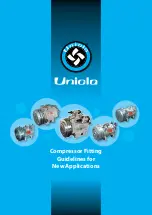
13-8-619 Page 10
INSTALLATION FOR COLD WEATHER OPERATION
(Figure 2-3, page 9) - It is recommended that the
unit be installed inside a shelter that will be heated to temperatures above freezing (32
o
F, 0
o
C). This will
eliminate many of the problems associated with operating units in cold climates, such as freezing in
control lines and downstream of the cooler.
Refer to Engineering Data Sheet 13-9-411 for the advantages of using the heat recovered from rotary
compressors. This heat recovery could easily pay for an adequate shelter for the unit.
When an outside installation must be made, the precautions required will depend on the severity of the
environment. The following are general guidelines for outside installations:
Cold Weather
(Down To +10
o
F)
1.
Be sure all drains, traps, and control lines, including pressure transducer lines are heated to avoid
freezing of condensate. Heat tape with thermostat control is generally satisfactory for this purpose
and can be obtained at various local plumbing or hardware outlets at nominal cost.
2.
Provisions to bypass the aftercooler must be made. Since cold air contains very little moisture,
successful operation can be achieved without the aftercooler.
3.
Provide at least some simple shelter such as a plywood windbreak to protect against drifting snow.
4.
Use only Gardner Denver AEON 9000 SP lubricant.
5.
Monitor unit carefully during start-up and operation to be sure it is functioning normally.
Remember unsheltered (outside) installations should be avoided where possible. Installation next to a
heated building where enough heat can be used to keep the compressor room above freezing will save
many complications in the operation and installation of the unit.
AUXILIARY AIR RECEIVER
- An auxiliary air receiver is not required if the piping system is large and
provides sufficient storage capacity to prevent rapid cycling. When used, an air receiver should be of
adequate size, provided with a relief valve of proper setting, a pressure gauge and a means of draining
condensate
OPTIONAL MOISTURE
SEPARATOR/TRAP
- The unit is equipped with a built-in aftercooler, a
combination moisture separator and trap is furnished as an option to the unit. This should be piped into
the system down stream of the aftercooler.
CONTROL PIPING
- Control piping is not necessary since the rotary screw unit is factory wired and piped
for the control system specified.
INLET LINE
- Where an inlet line is used between the air filter and the compressor, it must be thoroughly
cleaned on the inside to prevent dirt or scale from entering the compressor. If welded construction is
used, the line must be shot blasted and cleaned to remove welding scale. In either case, the inlet line
must be coated internally by galvanizing or painting with a moisture and oil-proof sealing lacquer. Up to
ten (10) feet in length, the inlet line should be the full size of the inlet opening on the compressor. If an
extra-long line is necessary, the pipe size should be increased according to “Inlet Line Length Chart”
below.
Accessibility for inlet air filter servicing must be considered when relocating the filters from the unit to a
remote location.
Содержание INTEGRA EFB99A
Страница 9: ...13 8 619 Page 2 300EFB797 A Ref Drawing Figure 1 2 COMPRESSOR ILLUSTRATION...
Страница 12: ...13 8 619 Page 5 DECALS 206EAQ077 212EAQ077 218EAQ077 211EAQ077 207EAQ077...
Страница 13: ...13 8 619 Page 6 DECALS 216EAQ077 217EAQ077 222EAQ077 221EAQ077 208EAQ077...
Страница 30: ...13 8 619 Page 23 300EFB542 C Ref Drawing Figure 4 3 WIRING DIAGRAM...
















































